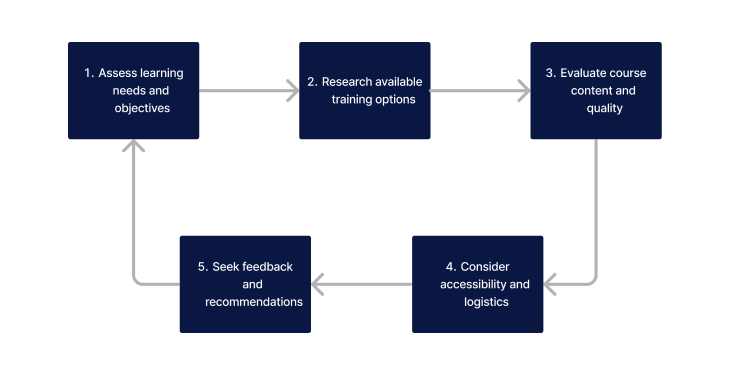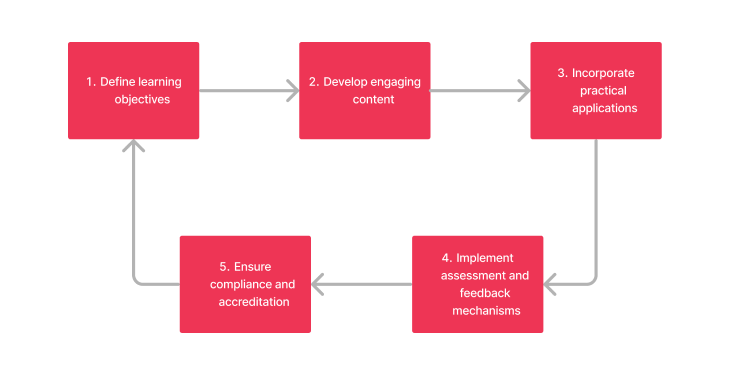Things to Consider When Selecting or Designing Training in Healthcare
In the dynamic landscape of healthcare, effective training is crucial for ensuring the delivery of quality services and the continuous professional development of care workers and health professionals. This article aims to provide education and learning development managers with comprehensive insights into the considerations involved in selecting or designing training programs within the healthcare sector.
What is Training in Healthcare?
Training in healthcare encompasses structured educational programs designed to enhance the knowledge, skills, and competencies of care workers and health professionals. It aims to improve patient outcomes, optimise operational efficiency, and ensure compliance with regulatory standards within the healthcare system.
What Types of Healthcare Training Exist?

Healthcare training encompasses various forms of education and development to equip professionals with the necessary skills and knowledge. Formal education includes academic programs offered by universities and colleges, such as nursing, medicine, and allied health professions, providing foundational knowledge and skills. Continuing education offers ongoing training activities to update healthcare professionals on advancements in their field, ensuring they remain current with best practices and emerging trends
- Formal Education: Academic programs offered by universities and colleges to prepare individuals for roles in healthcare, such as nursing, medicine, and allied health professions.
- Continuing Education: Ongoing training activities aimed at updating the knowledge and skills of healthcare professionals to keep pace with advancements in the field.
- On-the-Job Training: Hands-on learning experiences provided within healthcare settings to familiarise staff with specific tasks, procedures, and technologies.
- Professional Development Workshops: Short-term courses and seminars focusing on specialised topics relevant to various healthcare disciplines.
Examples of Training in Healthcare
- CPR and First Aid Certification: Essential skills for healthcare providers to respond effectively in emergencies.
- Electronic Health Record (EHR) Training: Training on using digital systems for efficient patient record management.
- Infection Control Procedures: Crucial training to prevent the spread of infections and ensure patient safety.
- Patient Communication and Empathy Training: Enhancing communication skills to provide compassionate care and support.
- Clinical Skills Enhancement Programs: Advanced training to improve diagnostic and treatment capabilities.
Considerations for Selecting Training in Healthcare
When selecting healthcare training, it's vital to ensure alignment with learning objectives, relevance to healthcare settings, and adaptability to diverse learning styles. Accessibility, incorporation of practical examples, compliance with regulations, availability of resources, and cost-effectiveness are also crucial factors to consider for effective training selection.
When selecting training in healthcare, it's essential to consider various factors:
- Alignment with Learning Objectives: Ensure that the training aligns with the desired outcomes and goals.
- Relevance to Healthcare Settings and Practices: Choose training that reflects the specific challenges and requirements of the healthcare environment.
- Adaptability to Different Learning Styles: Opt for training methods that accommodate various learning preferences and styles.
- Accessibility and Flexibility of Delivery Methods: Consider the availability of online, in-person, and blended learning options to accommodate diverse schedules and preferences.
- Incorporation of Case Studies and Real-Life Scenarios: Select training programs that integrate practical examples and case studies to enhance learning.
- Compliance with Regulatory Requirements and Industry Standards: Ensure that the training meets regulatory standards and requirements applicable to the healthcare sector.
- Availability of Training Materials and Resources: Assess the availability of supporting materials and resources to facilitate learning and skill development.
- Cost-Effectiveness and Return on Investment (ROI): Evaluate the cost of training against the potential benefits and outcomes for the organisation.
Considerations for Designing Training in Healthcare
When designing training in healthcare, consider the following:
- Identification of Learning Needs and Objectives: Conduct a thorough needs assessment to identify gaps and define clear learning objectives.
- Tailoring Content to Target Audience and Learning Styles: Customise training content to suit the specific needs and preferences of the target audience, considering different learning styles.
- Integration of Interactive Elements, such as Role-plays and Simulations: Incorporate interactive activities to engage learners and reinforce key concepts.
- Incorporation of Multimedia and Technology-Based Tools: Utilise multimedia resources and technology-enabled tools to enhance the learning experience and accessibility.
- Evaluation and Assessment Strategies to Measure Learning Outcomes: Implement robust evaluation methods to assess the effectiveness of the training and measure the achievement of learning objectives.
- Collaboration with Subject Matter Experts and Healthcare Professionals: Involve experts and practitioners in the design process to ensure relevance and accuracy of content.
- Continuous Review and Revision to Reflect Changes in Healthcare Practices: Regularly update and refine training materials to align with evolving best practices and industry standards.
- Evaluation and Assessment Strategies to Measure Learning Outcomes: Implement robust evaluation methods to assess the effectiveness of the training and measure the achievement of learning objectives.
What are the pros and Cons of designing your own training in healthcare?
The table below outlines the pros and cons of designing your own training in healthcare. Customisation allows tailoring content to specific organisational needs and preferences, while flexibility enables adaptation to staff availability and workflow demands.
| Pros | Cons |
|---|---|
| Customisation: Tailor training content to specific organisational needs and learner preferences. | Time-consuming: Designing customised training materials may require significant time and resources. |
| Flexibility: Design training schedules and formats that accommodate staff availability and workflow demands. | Expertise: Designing effective training requires expertise in instructional design and healthcare content. |
| Cost-effectiveness: Designing in-house training may be more cost-effective than purchasing pre-packaged solutions. | Quality assurance: Ensuring the quality and effectiveness of internally designed training may be challenging without external validation. |
| Alignment: Ensure training content aligns closely with organisational goals, practices, and culture. | Resource constraints: Limited resources may restrict the scope and depth of internally designed training programs. |
| Engagement: Design interactive and engaging training experiences that promote active learning and knowledge retention. | Development time: Designing comprehensive training programs may require extended development periods. |
Need an LMS that can facilitate training module creation?
Contact Ausmed today and see how we can support your organisation!
How to Select Training in Healthcare

Here are steps to effectively select training in healthcare:
- Assess Learning Needs and Objectives: Identify specific areas for skill development and knowledge enhancement within the healthcare team through surveys, performance evaluations, and stakeholder consultations.
- Research Available Training Options: Explore a variety of training providers, courses, and delivery methods to determine the best fit for your organisation based on factors such as content relevance, accreditation, and cost.
- Evaluate Course Content and Quality: Review course syllabi, outlines, and feedback from previous participants to gauge the relevance, effectiveness, and quality of the training.
- Consider Accessibility and Logistics: Ensure that the training program is accessible to all participants and can be accommodated within existing schedules and resources, considering factors such as location, timing, and delivery format.
- Seek Feedback and Recommendations: Consult with colleagues, industry peers, and professional networks for insights and recommendations on reputable training providers and programs, leveraging online reviews and testimonials.
How to Design Training in Healthcare

- Define Learning Objectives: Clearly articulate the desired knowledge, skills, and behaviors that participants should acquire through the training program, ensuring alignment with organisational goals and industry standards.
- Develop Engaging Content: Create dynamic and interactive learning materials that capture learners' interest and promote active participation, incorporating multimedia elements, case studies, and real-life scenarios.
- Incorporate Practical Applications: Provide opportunities for hands-on practice and skill development through simulations, role-plays, and experiential learning activities, fostering the application of knowledge in real-world healthcare settings.
- Implement Assessment and Feedback Mechanisms: Design comprehensive assessment tools and feedback mechanisms to monitor participant progress, measure learning outcomes, and identify areas for improvement, ensuring ongoing refinement of the training program.
- Ensure Compliance and Accreditation: Align the training program with relevant regulatory requirements, industry standards, and professional guidelines, seeking accreditation from recognised accrediting bodies to enhance credibility and quality assurance.
Conclusion
In conclusion, selecting and designing training programs in healthcare is a multifaceted process that requires careful consideration of various factors. By aligning training with specific learning objectives, healthcare settings, and industry standards, education and learning development managers can ensure the continuous professional development of care workers and health professionals. Moreover, by incorporating interactive elements, leveraging technology, and fostering collaboration with subject matter experts, training programs can be tailored to meet the diverse needs and preferences of participants.
Related Resources
- How to Create a Culture of Continuous Learning
- How to Manage an Effective Staff Training Program
- How Can I Use Peer Feedback to Enhance Learning?
- 360-Degree Feedback in Learning and Development
- How Can I Implement Self-Directed Learning Strategies?
- Conducting "Pre-Training Interviews" Before Education
- How Flexible Learning Can Boost Employee Engagement and Retention
- How Do I Design Inclusive Learning Programs?
References
Department of Health. (2022). Healthcare Training Guidelines. Retrieved from https://www.health.vic.gov.au/health-workforce/education-and-training
Buljac-Samardzic, M., Doekhie, K.D. & van Wijngaarden, J.D.H. (2020). Interventions to improve team effectiveness within health care: a systematic review of the past decade. Human Resources for Health, 18(2).



